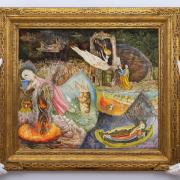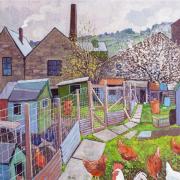An important arts site in Langdale, made famous by faces an uncertain future.
The future of the site where one of the most iconic art pieces of the 20th century was created hangs in the balance this year. Starved of funds, the charity which owns The Merz Barn in Langdale in the Lake District will either sell it to a developer or find a benefactor to enable them to maintain it as a rural arts hub inspiring students and artists from around the world.
Merz Barn sits in Cylinders site and is where German-born Kurt Schwitters was working on his last great work when he died in January 1948.
The site, including the Merz Barn, was bought by Rossendale-based Littoral Arts in 2007 with the help of the Arts Council, Northern Rock Foundation and Damien Hirst, who sold one of his pieces for £150,000 to support the project to commemorate the life and works of Schwitters.

Littoral Arts principals Ian Hunter, 75, and Celia Larner, aged 85, have restored the barn and the surrounding estate, held conferences, exhibitions and events, and welcomed artists and students from Japan to Mexico as well as from universities and arts schools all over the UK.
Now, without the support of the Arts Council and their advancing years, they are having to decide the site’s future.
Cylinders has a long and varied history. Until the 1920s it was a storage area for gunpowder works and was a post-industrial wasteland when acquired by expert landscape gardener Harry Pierce in the 1930s.
Pierce, a disciple of Scorton-born arts and crafts gardener, Thomas Mawson, planned to turn Cylinders into a Kew Gardens of the north and imported exotic plants from all over the world. Some maples, rhododendra and azalea still stand alongside native trees which self-seeded and produced the idyllic mix which gives the site such charm.
One of the many achievements of Littoral Arts has been to build a mini museum devoted to Mr Pierce in his old drawing room.
It was while painting Mr Pierce’s portrait that Kurt Schwitters, who ended up in the Lake District via Norway, an Isle of Man prisoner camp and London, had the idea of completing his last Merz Barn installation in the style of his Merz Bau, back in his home city of Hanover.
It was 1947 and he had just received a cheque for $1,000 from the Museum of Modern Art in New York, who wanted him to create such a Merz installation in America. But Kurt asked if, instead, he could create it at Cylinders. They agreed and he had completed one wall of his Merz Barn installation before dying in January 1948 in a pauper’s hospital in Kendal.
If no one picks up the baton of commemorating Schwitters at Cylinders, it won’t be the first time it has been abandoned.
After he died, he was initially buried in Ambleside parish graveyard, still marked with a gravestone with the legend “Creator of Merz”. His body
was later repatriated to his native Germany.
But the barn with its priceless artwork was left to the elements and Schwitters’s Lake District connection forgotten.
But it so happened that the art teacher at nearby Charlotte Mason College, Mary Burkett, attended a Kurt Schwitters exhibition in Belgium where the catalogue noted in passing that he had died in the Lake District, ten years earlier.
Ms Burkett was aware of Schwitters’s world-wide reputation as a pioneer of the modern art movement, but unaware of his Ambleside connection. When she returned to Ambleside, she researched this link and sent her students around the town looking for his artworks. They found pieces he had created in payment for goods and services and discovered the Harry Pierce connection.
She was alarmed to find the decaying wall and alerted the Tate which involved Richard Hamilton, one of the UK’s most prominent modern artists and a huge fan of Schwitters.
He arranged to have the wall detached from the barn and taken 100 miles on a low loader to Newcastle upon Tyne, a significant engineering achievement.
Mr Hamilton was an arts professor at Newcastle University and the wall can still be seen in its Hatton Gallery. It is insured for £15 million, but is priceless as Schwitters’s two other Merz installations were destroyed. His first in Hanover was bombed by the RAF. The second in Norway was vandalised.
After the wall was moved in 1964, Cylinders was forgotten again until the late 1990s when various artists and academics got together to try to revive the site. Among those involved were Celia Larner and Ian Hunter of Littoral Arts, based in Turn, Rossendale, which bought the site from
Mr Pierce’s grandson.
For the first six years the Arts Council were fully supportive of Littoral and Nick Serota, then director of the Tate and later chair of the Arts Council, said the UK had a moral duty to support the Cylinders project and Littoral should not be expected to carry the burden alone.

However, since 2012, Arts Council England (ACE) has withdrawn support, turning down the last nine grant bids from Littoral, mainly on the grounds that they did not have enough Arts Lottery funding available at the time.
When turning down one application, an ACE official told Littoral it would not be getting further financial support and if none was forthcoming from elsewhere, the charity should consider selling up.
Instead, Merz Barn director Ian Hunter and the chair of Littoral Celia Larner have sold their own property and used their pensions to keep the
project going.
But after ACE refused to support the 75th anniversary in 2022 of Schwitters’ last great artwork, Littoral has had to accept the project cannot achieve its aims unless there are new owners or new benefactors.
Mr Hunter said: ‘We are prepared to negotiate with whoever is prepared to help preserve this iconic site. But if no one comes forward by March then we will have to put it up for auction. It could go to anyone at that stage.’
The danger is that the site will be bought by a commercial concern for chalets, glamping or similar. There is even the fear it will become a car park.
If the Arts Council had continued its support, Littoral were planning a Merz Shed to act as a gallery and information centre, a small Merz Museum and ideally a three-dimensional replica of the Merz Barn Wall.



























